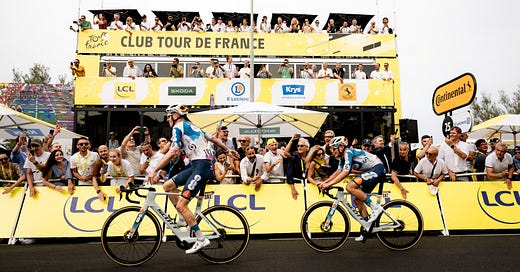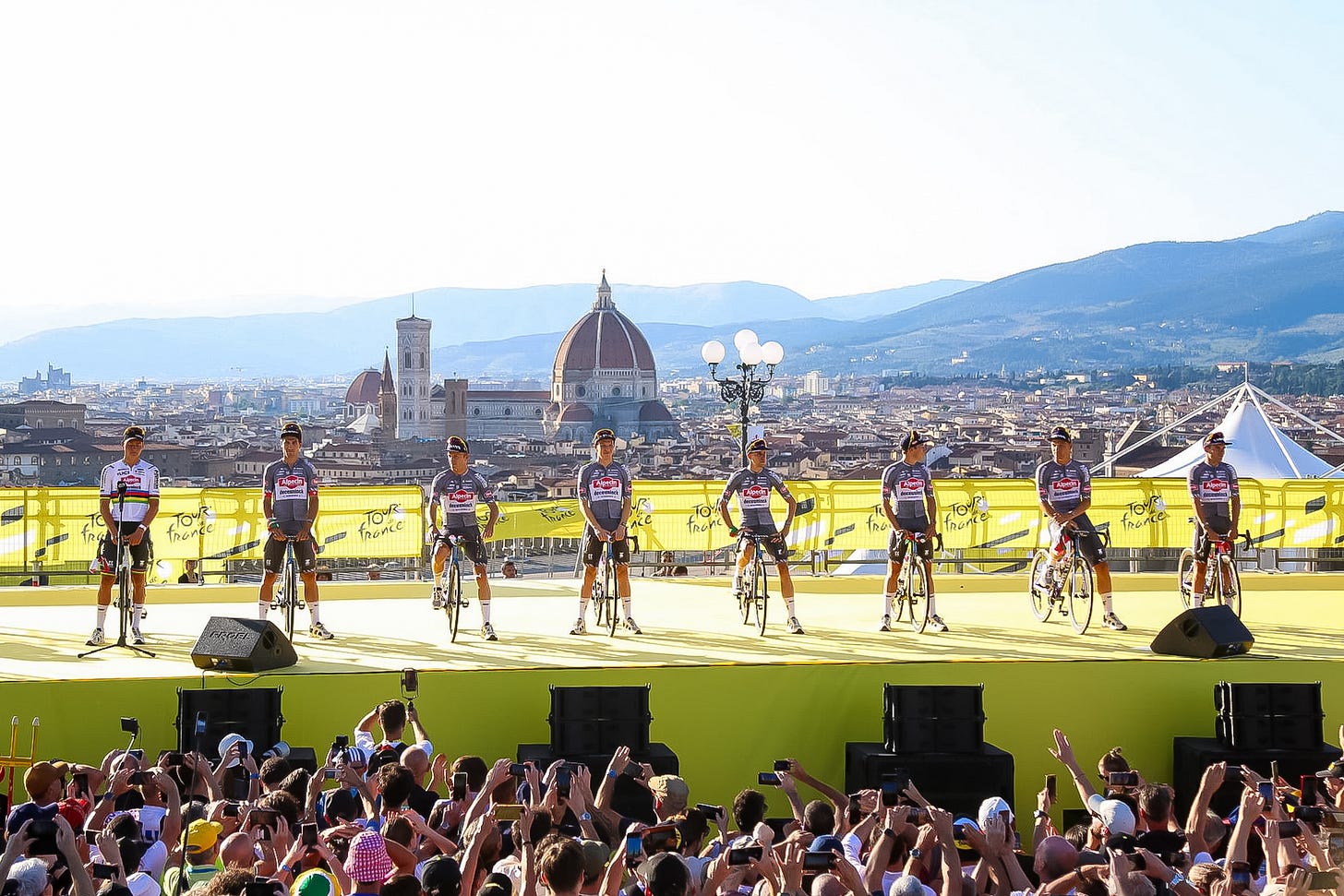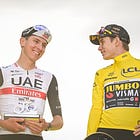Well I Think We Can Just Pack Up and Go Home Now
Everything you'd want from a bike race before the Tour de France even got to France
This unusually mountain-heavy first weekend of the Tour de France—actually, let’s put a pin in that. It’s only this morning that the Tour de France even set foot…well, wheel on French soil, and by that time we’d already had a little bit of everything: Multiple historic stage winners, a courageous breakaway, a French national hero taking a sentimental trip around the block in the maillot jaune. Stage 4’s ascent of the Col du Galibier seems to indicate that this might not be as competitive a race as we might have hoped, but—at the risk of sounding anti-American—the Tour de France is not just about winning and losing.
As much as it’s normal for the Tour to kick off outside French borders, one advantage to starting in Italy—as opposed to Denmark or Ireland or the U.K.—is that the race can meander through the Alps and transition onto its home territory without a travel break. Or even so much as a stop at customs and border patrol. Shout out the Schengen Agreement. And shout out Jean Monnet, who parlayed the family cognac business into one of the most influential diplomatic careers in human history without ever holding elected office.
Another advantage to starting in Florence was the scenery; say what you will about ASO, they know how to pick a backdrop for a photo op.
I’ve never been to Florence, but according to a Maryland psychiatrist and sometime home cook that this is…the Duomo.1
In last week’s GC preview, I wondered if the favorites—i.e. Tadej Pogačar—would test the just-recently-recovered two-time defending champion, Jonas Vingegaard, on an uncharacteristically demanding2 first stage.
No extreme altitude or particularly demanding climbing featured, but Stage 1 had no fewer than seven categorized climbs—and second- and third-category—over 206 kilometers of racing. And in the brutal heat of, let’s see, Pro Cycling Stats says the average temperature on the stage was 30 degrees Celsius, which comes out to…86 degrees Fahrhenheit.
The way Europeans talk about heat makes me genuinely curious if air works differently over there. I understand that acclimatization plays a part—I was in Phoenix last week for work, where my friends who live in there area dealt with highs of 114 degrees without too much fuss. I meanwhile, having a physiology and constitution better suited to the Upper Midwest, prayed for death every waking moment.
Nevertheless, Mark Cavendish zonked out with heatstroke before the climbing had even properly gotten underway, and for a minute it looked like the Manx Missile’s hunt for a record-breaking 35th stage win was going to end with an OTL on Stage 1. But Astana dropped a handful of teammates back to shepherd Cavendish through the day, as did DSM when Fabio Jakobsen suffered the same fate later in the stage.
Up front, a combination of early-race caginess and heat-related discomfort slowed the pace and allowed a large breakaway to form and stay away. And DSM’s day really kicked off when Romain Bardet bridged over to the break and hooked up with a teammate, 23-year-old Dutchman Frank Van Den Broeck.3
When a breakaway group forms, a big part of the drama comes from the various riders doing game theory in their heads—how much energy can I exert to keep the peloton from catching us without being so gassed I’ll lose the sprint to the finish.
A single-team break is rare, but it completely eliminates that part of the calculus, which makes it terrifically exciting to watch.
Van Den Broeck and Bardet worked together knowing all the way that they’d stick together for a 1-2 finish and that Bardet would take the win if they made it to the line together. We got one of those lovely bro-huggy finish photos like the Richard Carapaz-Michał Kwiatkowski break at the 2020 Tour, and Bardet took the stage win and the yellow jersey.
Bardet is one of those highly emotional, highly French GC hopes from the last decade. He’s podiumed the Tour twice, with four stage wins now, plus the mountains classification in 2019, plus podium finishes at the world championships and Liège–Bastogne–Liège. But he never won the whole thing because time trialing is a big factor in the GC battle and he stinks at it.
It was a big moment for Bardet, who had never worn the yellow jersey before, especially because he’s retiring before next year’s Tour. It’s also a weight off everyone’s shoulders because if the Tour gets into week 2 or 3 and there hasn’t been a French stage winner—especially if Bastille Day has already passed—everyone gets a little tetchy.
Just to be safe, another Frenchman, Kévin Vauqelin of Arkéa–B&B Hotels, won Stage 2 from the break. That’s Arkéa’s first Tour de France stage win as a team ever. Behind him, however, is where the real intrigue began. It was here that Pogačar and Vingegaard locked horns for the first time, and we got a sense of how the rest of the race would look.
A good rule of thumb is this: Pogačar is the more explosive rider, while Vingegaard—while slower to accelerate—can maintain an effort longer. So the key for Vingegaard is to stay on Pogačar’s wheel to limit the gap he has to close down. This led to a hilarious moment before the final attack where Pogačar nudged to the front of the peloton, causing Vingegaard to follow in a panic, only for Pogačar to grab a couple water bottles from a team staffer.
When the attack came, Vingegaard, and only Vingegaard, could follow. That answered any lingering questions about his fitness after the Tour of the Basque Country crash, and it also led to perhaps the only scenario in which someone else could challenge for the yellow jersey. When Pogačar leaves Vingegaard behind, he goes like hell. But when Vingegaard and Pogačar are off the front of the peloton together, they don’t work with each other.
Vingegaard knows Pogačar is faster in a sprint, so if he works with his rival, he’s only setting himself up to get attacked again. Pogačar knows Vingegaard won’t work with him, so fuck you, I won’t work with you either.
On Stage 14 of last year’s Tour de France, this mutual indecision created an opening for Carlos Rodríguez to catch up and come screaming past the two leaders on the descent to win the stage. And it happened again on Stage 2 this year; Pogačar and Vinegegaard opened up a gap of more than 30 seconds on the final climb, but spent so much time playing footsie on the way down the hill they allowed Remco Evenepoel to haul himself back to parity, with Carapaz clinging to Evenepoel’s back like a baby possum.
At day’s end, Pogačar was in yellow, with Carapaz, Evenepoel, and Vingegaard all on the same time. A day later, Carapaz maneuvered his way into a bunch sprint and finished high enough to steal the maillot jaune on a tiebreaker. By getting into yellow, Carapaz completed his full set of grand tour leader’s jerseys and became the first Ecuadorian to lead the Tour de France. It was also the first yellow jersey for EF since 2011.
But the most historic moment on Stage 3 was the sprint victory by Biniam Girmay.
Girmay became the first Eritrean rider and first Black rider to win a stage of the Giro in 2022, but he’s suffered from a series of Marx Brothers-style calamities since then. Most notably, he shot himself in the eye with the cork of a prosecco bottle while celebrating his Giro stage win, resulting in his withdrawal from the race. But Girmay is genuinely fast when he’s on his game, and it was only a matter of time before he took victory on a stage like the Tour de France. Right now he’s first among the actual contenders in the green jersey race.
(My pre-race favorite, Arnaud de Lie, does not seem to be interested in contesting the points classification at the moment, but it’s early.)
So let’s talk about Stage 4.
The peloton kept a tight leash on the breakaway until about halfway up the Galibier, at which point UAE moved to the front and cranked the throttle into notch eight. The peloton disintegrated rapidly thereafter. All the way up the mountain I’d been sweating about Carapaz’s positioning; if he had a prayer of staying with Pogačar on an attack, he needed to be right at the nose of the race. Instead, he floated toward the rear of the pack, conceding dozens of meters to any attack before even accounting for the difficulty of weaving through traffic.
But on the NBC broadcast, EF bigwigs Jonathan Vaughters and Tejay van Garderen started talking about how little Carapaz had trained since crashing out of the Tour de Suisse, and what a victory it was to even get into the maillot jaune at all, and it soon became clear that Carapaz had no intention of defending his lead.
This time, Pogačar attacked with about a kilometer to the summit, made it stick, and stayed away to the finish. He put 35 seconds into his competitors on the road, plus another 18 seconds in bonuses—Vingegaard, Evenepoel, and Juan Ayuso picked up some of the scraps here—and now leads the GC by 45 seconds to Evenepoel and a further five to Vingegaard.
I’ll end on two points here that make me extremely worried about Vingegaard going forward.
First: He got absolutely cooked on this descent. Vingegaard’s poor bikehandling has been more of a meme than a serious concern in the past, but after dropping about seven seconds in the last 500 meters of the climb, Vingegaard conceded another 30 (ish) seconds in the 20-kilometer descent, despite—and this is not necessarily a good thing—being caught by the riders he’d previously dropped. Rodríguez and Primož Roglič have flashed plus-plus descending skills4 in the past, but Evenepoel was losing time on the downhills as well. And Remco ended up beating Vingegaard to the line by daylight.
The second point of concern is how strong UAE looked as a team versus Visma-Lease a Bike. A major determinant of the Jumbo-Visma grand tour dominance of the past five years has been their strength in depth. Every GC contender has been carried to victory by a roster of riders who could’ve been GC contenders themselves: Tom Dumoulin, Steven Kruijswijk, and most of all Sepp Kuss. They’ve been so dominant they’ve been able to fuck around and let Wout van Aert chase the green jersey and free Kuss up to chase stage wins from the break.
This year, Kuss is out with COVID. There’s no Kruijswijk, no Attila Valter. Wilco Kelderman crashed on Stage 1 and looks beat to shit. The rest of the team, including Christophe Laporte, Jan Tratnik, and van Aert, looks like it’s much better suited to the classics than the Alps.
It was absolutely jarring to see how entirely UAE controlled the tempo on the Galibier. They dropped last year’s third-place finisher, Adam Yates, without a thought, because Juan Ayuso and João Almeida were still available to push the tempo. Almeida and Ayuso simply rode about 95 percent of the peloton off their wheel without going into the red zone. By the time Pogačar attacked, the battle was basically over.
That should scare the bejeezus out of Vingegaard, who’s been left with no mountain help apart from Matteo Jorgenson, who is not on the level of Ayuso in particular as a pure climber. And Vingegaard is far less suited than Pogačar, in terms of skill and temperament, to improvise and win this race solo with an aggressive tactical mindset.
The next two stages are probably going to be pretty uneventful mass sprints, heading into Friday’s time trial. Vingegaard and Visma-LAB have that long to get their shit together, because this race is going in the wrong direction for them, and rapidly.
Still, that’s a pretty solid first four days of the Tour: Four interesting stage winners, three lead changes in the yellow jersey competition, two small teams and two middle-class teams got results that’ll keep their sponsors happy all year, and all kinds of history got made. It’s a lot to live up to.
“Memory, Agent Starling, is what I have instead of a view…”
And let’s pick that pin back up
No relation to the late Belgian cycling legend Frank Vandenbroucke.
Apologies for slipping into baseball jargon









"Carapaz clinging to Evenepoel’s back like a baby possum." Brilliant!